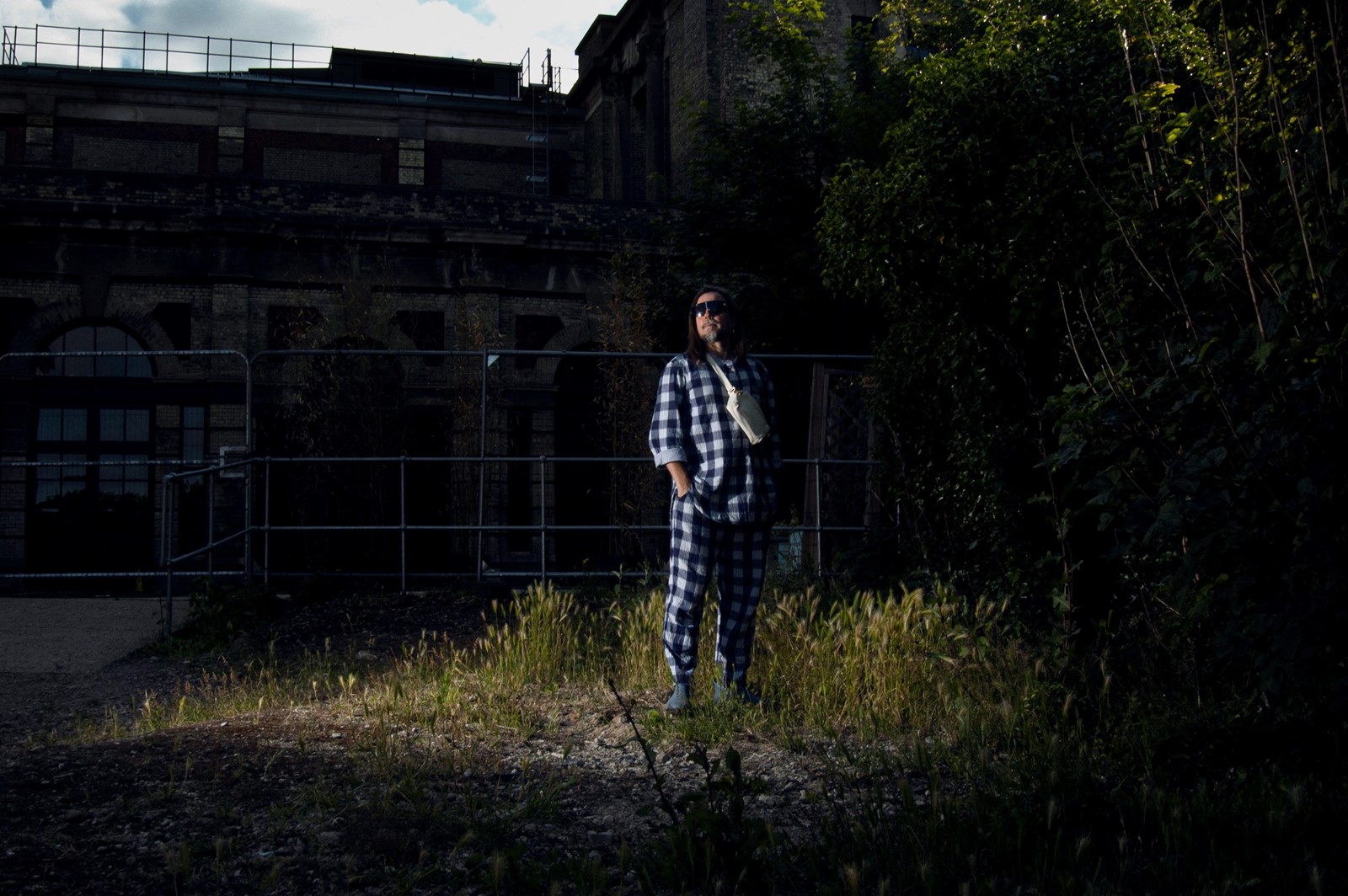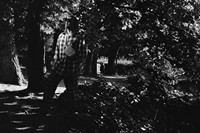This excerpt is taken from the eighth issue of Plaster Magazine.
Suddenly, it hits you. A moment of clarity cuts through the fog of skunk and bassline-induced tinnitus, and for the first time, life makes sense. Just like that, from the crumbled floor of a North London bolthole, your existential dilemmas are solved, only to return the next day as you wonder what the fuck happened. This might sound familiar. Indeed, you would be forgiven for thinking this was just another party experience typical of the years Mark Leckey spent squatting. In fact, it’s my first encounter with the creative magpie’s work.
Shown at Cubitt Gallery in Islington, Affect Bridge was an exhibition exemplary of Mark’s creative approach. Bringing together gritty fragments of Britain, the show took place in a box room, lit with Lucozade-hued sodium lamps. The effect was disorientating, if not trippy, and completely intentional. Homing in on a like-for-like model of a graffitied flyover, the installation was soundtracked with an especially haunting sermon, written by Leckey in the hope of exorcising his stagnant memories.
Speaking a honeyed scouse, the artist appears in sunglasses following a bout of hay fever (it’s June, FYI). “My eyes are fucked,” he assures me with immediate familiarity. Polite but without façade, Mark wears his heart on his sleeve, dotting between the profound and downright banal in an instant. Raised in Ellesmere Port, an overspill town that skirts Liverpool, Leckey tells me he has always seen himself as an outsider. “They call us ‘woolly backs’ or ‘plastic scousers’,” he says. But why would a man of his stature still be so cut up over regional gripes around authenticity? “It’s your identity, isn’t it?” he says.
Indeed, it was Mark’s fixation on identity that first captured the art world’s attention with Fiorucci Made Me Hardcore (1999), a filmic depiction of Britain’s dance music subcultures that journeys from seventies northern soul to nineties rave. Splicing archival footage from northern England’s dance halls and clubs, the veteran raver slurs over scenes like a warped record. Despite the drunken editing, it earned Leckey a Turner Prize in 2008, long before today’s YouTubers had ever considered montaging videos from warehouse parties. Since, Mark has honed a characteristically creepy style defined by uncanny figures and quick jumps from melancholia to ecstasy.
Today, Mark sits down in his garden for a candid conversation over Zoom. The result is a hotchpotch interview-cum-catchup, clustered with nuggets of SoundCloud rap, West Ham lads, My Little Pony, and an earnest discussion of appropriation.
Joe Bobowicz: Are you a crate digger?
Mark Leckey: I would never call myself a crate digger, but I definitely have that impulse. Going into a record shop and fingering through old LPs in a crate doesn’t appeal to me. I have the same sort of drive to find forgotten or obscure stuff. I have the mentality, but it’s more a knowledge that there is some weird and wonderful stuff out there, so I keep digging.

JB: That makes me think of your lecture/artwork, The Cinema in the Round, which features a lot of weird moments, from the CGI ship sinking in Titanic to that weird Simpsons episode, Homer 3D. Does that tie into this for you?
ML: Yeah, it’s about finding stuff. It’s funny you say that because I got scolded for the Titanic thing. With a lot of this, it’s basically appropriation. There’s sometimes a wilful ignorance with crate digging where you’ll dig out an obscure soul sample and not pay your respects or acknowledge the original musician. In this desire to find things [as if] they just magically appeared to you, you’re not considering their production. And I got caught with the Cinema in the Round. I had heard this idea of the Titanic being a sculpture that goes from horizontal to vertical, and obviously, I stored it in my crate. The person who had originally said it, Jerry Saltz, a New York critic, pulled me up about it, quite pissed off that I had nicked his line and not credited him.
JB: In the film for Cinema in the Round, you do credit him, though.
ML: As I’ve become more successful, I have to be aware of not nicking stuff from… I’m happy to take stuff from above. It’s more taking stuff from below – it’s that idea of punching down.
JB: Is that partly because when you started out, you were signing on [for unemployment benefits], and now you’re in a very different situation?
ML: Exactly.

JB: Did you need to rethink it?
ML: I have. I don’t use as much found imagery as I used to. I had a record out during lockdown, and I used a meme for the cover. It was these West Ham football hooligans calling out Everton fans, but they looked ridiculous. The Everton fans mocked them, drawing on this image. I used that because it so accurately conjured up everything that I felt at that time about where I had come from, having two daughters and the world having this weird, digital, slightly magical realm. Anyway, it was irresistible. I tried to find out who made it and said publicly, ‘If you see this, just give me a shout, and I will offer you recompense.’
JB: It described how you were feeling and also your experience in the past?
ML: Yeah. It’s a photograph, originally, of four – I call them scallies, you call them road men – and they’re trying to look hard. Everyone mocked them by putting on the most ridiculous accessories – really girly things – feminising or sissifying them. It made a sympathetic image. I thought maybe that’s more like what boyhood is now. That aggressive, masculine energy I grew up with, it’s still there, but not as dominant.
JB: What are you listening to?
ML: There’s a particular sort of trap: mumble, SoundCloudy … I love Young Thug and am always looking for the more psychedelic end of that. I like it when it gets really fucked up. When they’ve been doing loads of molly and purple drank, and it gets all strange. I like early-70s kraut prog-rock, too.
Issue eight of Plaster Magazine is out on February 23.






